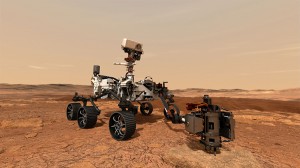Perseverance Rover Begins Long Journey to Mars
On July, 30, 2020, a rocket blasted off from Cape Canaveral in Florida as part of the United States National Aeronautics and Space Administration (NASA) Mars 2020 mission. The mission consists of Perseverance, the largest rover ever sent to Mars. Perseverance is the size of a small automobile and weighs over 2,200 pounds (1,000 kilograms) on Earth.
The design of Perseverance is based on that of the Mars Science Laboratory (MSL) rover Curiosity, which has been exploring Mars since 2012. Engineers used many extra components that were originally created as backups for Curiosity in case of manufacturing defects in the originals. But Perseverance is more than just a pile of spare parts. Jet Propulsion Laboratory (JPL) scientists and engineers modified—and beefed up—the design to fit Perseverance’s mission. Perseverance is about 5 inches (13 centimeters) longer and 278 pounds (126 kilograms) heavier than Curiosity.
Perseverance will land on Feb. 18, 2021, in Jezero Crater. To descend to the Martian surface, the mission will use the sky crane system pioneered by MSL. A parachute will slow the craft after it enters the Martian atmosphere. A set of rockets will then lower the rover to the ground on a tether.
Jezero Crater once held a lake that was fed by a river system. Perseverance will explore this ancient river delta and search for signs of past life there. The rover carries many sophisticated scientific instruments that will enable it study the geology and climate of the region.
Perseverance is designed to operate for at least one Martian year, about 98 weeks. But NASA’s recent track record points to an even longer tour of duty. Other NASA robotic missions to Mars, such as Curiosity and the earlier twin rovers Spirit and Opportunity, remained operational many years after their planned mission time.
Mars reaches a favorable position for spacecraft to reach it from Earth about once every two years. The Mars 2020 launch was part of a busy launch window. On July 19, the United Arab Emirates launched an orbiter towards Mars. The satellite, called Hope, will collect data on the Martian atmosphere. On July 23, China launched an ambitious orbiter-lander-rover combination called Tianwen-1. These countries’ space agencies would be just the fifth and sixth to send successful missions to Mars, behind the former Soviet Union, the United States, the combined European Space Agency (ESA), and India.



